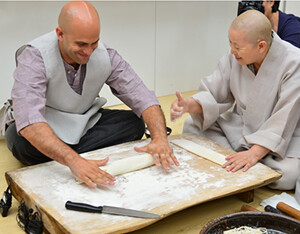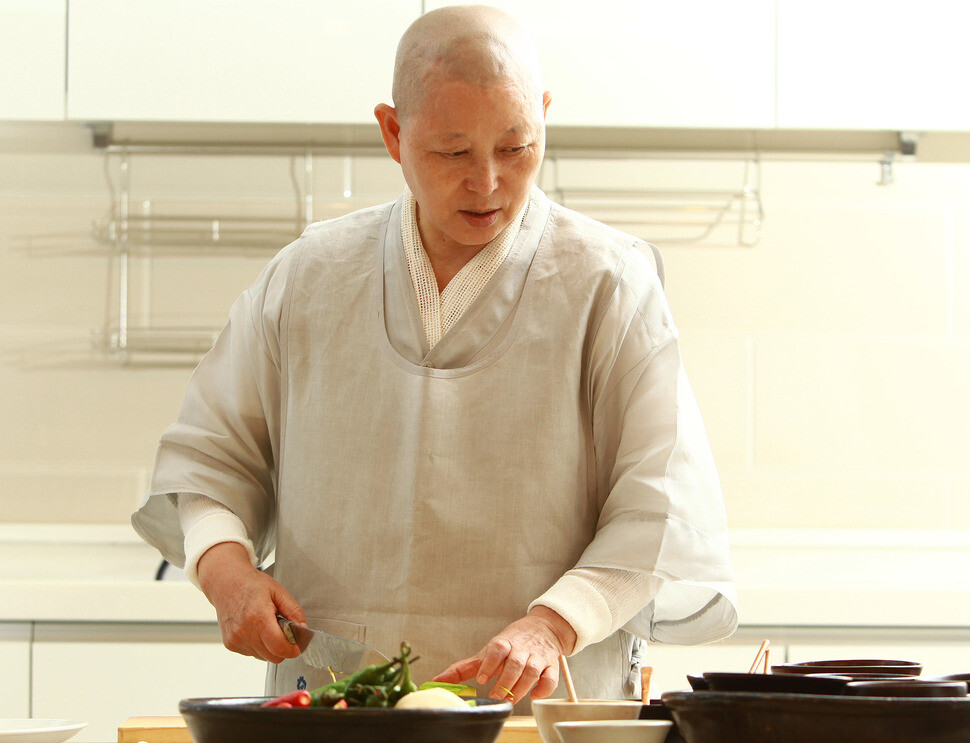hankyoreh
Links to other country sites 다른 나라 사이트 링크
Korean temple cuisine garnering western attention

In recent years, Korean temple food has been gaining recognition both as a cuisine that is appropriate for contemporary lifestyle, which involves a lot of time sitting in front of computers, and as a uniquely Korean traditional cuisine.
On a visit last year to South Korea, Sam Kass, former Senior Policy Advisor for Nutrition Policy and Assistant Chef at the White House said, “President Obama asked me to learn how to cook bulgogi, but I’m going to make him kongguksu (cold noodles in a soybean milk), which I learned at a Buddhist temple in Korea.”
Kass learned how to cook kongguksu and oimulgimchi (cucumber kimchi in water). Last year, Kass visited Jingwan Temple, a Buddhist temple for bhikkhuni, or female monks, located on the slopes of Bukhan Mountain in Seoul.
President Obama’s favorite Korean food is bulgogi, according to reports.
Last month, Dr. Jill Biden, wife of Vice President Joe Biden, stopped at Jingwan Temple on her first visit to South Korea. Biden reportedly added the visit to her itinerary herself because she wanted to know how South Korean women are inspired by female monks. According to the White House blog, Biden stopped by a number of temples and was intrigued by the rich flavor of doenjang (soybean paste), a sauce that is unique to Korea.
As this suggests, countless famous figures have stopped by Jingwan Temple to taste its food. Along with celebrities like Richard Gere, Ren? Redzepi, chef of Denmark’s Noma, one of the most famous restaurants in the world, also visited the temple in Nov. 2014.
Noma is a concept restaurant that relies entirely on food grown in Denmark, eschewing Mediterranean ingredients such as olives and even wine. Since 2010, Noma has appeared on the list of the world’s finest restaurants selected by British culinary magazine Restaurant no less than four times.
In August of last year, Peter Zumthor, winner of the Pritzker Prize - considered the Nobel Prize of architecture - came to South Korea for four days. When he visited Jingwan Temple on the first day of his visit, he was so enchanted that he ended up spending the night.
Given its 1,700-year history and the flavor it achieves without using meat, temple food has sparked interest among Westerners who are worried about obesity.
“Since temple food preserves the aromas and the atmosphere of the temple, it feels like you’re dining on nature. In Europe, food is only regarded as a source of pleasure rather than being treated with dignity,” said Redzepi during an interview with the Kyunghyang Shinmun.
Redzepi also said that he wanted to make a vegetarian version of Noma.
Ven. Gyeho, abbot at Jingwan Temple, said that the three principles of temple food are cleanliness, flexibility and lawfulness. Vegetables are to be clean, in season and unrefrigerated; they should be blanched or boiled until tender; and dishes should be prepared according to the will of the Buddha.
Temple food provides monks - who perform few physical tasks - with the energy to focus on their religious practice. It is easy to digest, since it does not include pungent spices such as leeks or garlic.

By Kwon Eun-jung, staff reporter
Please direct questions or comments to [english@hani.co.kr]

Editorial・opinion
![[Column] Park Geun-hye déjà vu in Yoon Suk-yeol [Column] Park Geun-hye déjà vu in Yoon Suk-yeol](https://flexible.img.hani.co.kr/flexible/normal/500/300/imgdb/original/2024/0424/651713945113788.jpg) [Column] Park Geun-hye déjà vu in Yoon Suk-yeol
[Column] Park Geun-hye déjà vu in Yoon Suk-yeol![[Editorial] New weight of N. Korea’s nuclear threats makes dialogue all the more urgent [Editorial] New weight of N. Korea’s nuclear threats makes dialogue all the more urgent](https://flexible.img.hani.co.kr/flexible/normal/500/300/imgdb/original/2024/0424/7317139454662664.jpg) [Editorial] New weight of N. Korea’s nuclear threats makes dialogue all the more urgent
[Editorial] New weight of N. Korea’s nuclear threats makes dialogue all the more urgent- [Guest essay] The real reason Korea’s new right wants to dub Rhee a founding father
- [Column] ‘Choson’: Is it time we start referring to N. Korea in its own terms?
- [Editorial] Japan’s rewriting of history with Korea has gone too far
- [Column] The president’s questionable capacity for dialogue
- [Column] Are chaebol firms just pizza pies for families to divvy up as they please?
- [Column] Has Korea, too, crossed the Rubicon on China?
- [Correspondent’s column] In Japan’s alliance with US, echoes of its past alliances with UK
- [Editorial] Does Yoon think the Korean public is wrong?
Most viewed articles
- 1‘We must say no’: Seoul defense chief on Korean, USFK involvement in hypothetical Taiwan crisis
- 2N. Korean delegation’s trip to Iran shows how Pyongyang is leveraging ties with Moscow
- 3‘Weddingflation’ breaks the bank for Korean couples-to-be
- 4[Reportage] On US campuses, student risk arrest as they call for divestment from Israel
- 5Amnesty notes ‘erosion’ of freedom of expression in Korea in annual human rights report
- 6[Column] Park Geun-hye déjà vu in Yoon Suk-yeol
- 7Korea sees more deaths than births for 52nd consecutive month in February
- 8[Editorial] New weight of N. Korea’s nuclear threats makes dialogue all the more urgent
- 9Will NewJeans end up collateral damage in internal feud at K-pop juggernaut Hybe?
- 10[Guest essay] The real reason Korea’s new right wants to dub Rhee a founding father